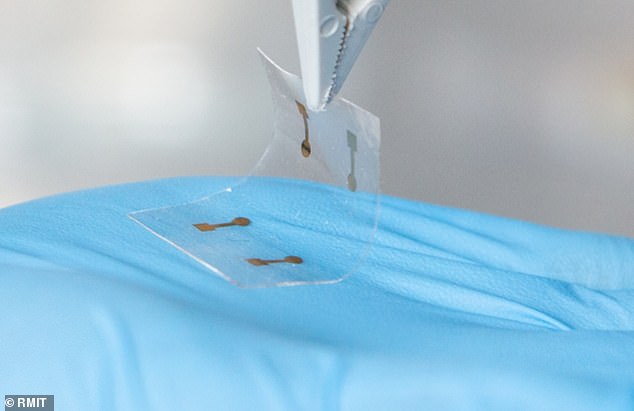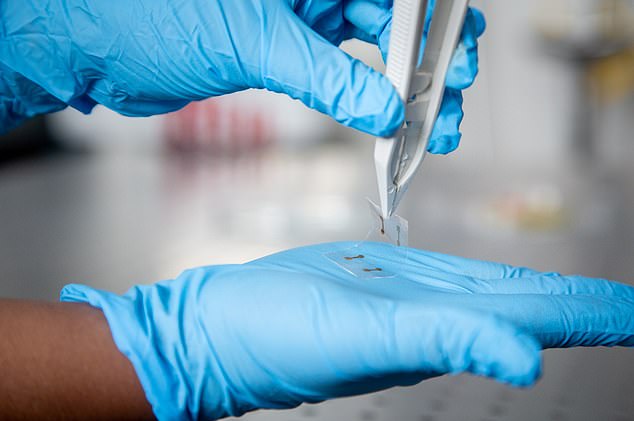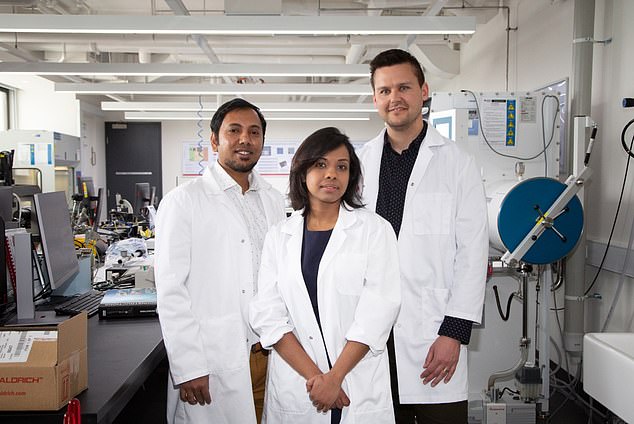Touchscreen of the future? Scientists develop a new ultra-thin 'twisty' electronic material that can be rolled into a tube and printed like newspaper
- Nano-thin display is 100 times thinner than existing touchscreen materials
- Aussie scientists used liquid metal printing technique to make display concept
- Screen could be printed at low-cost like today's newspapers at a printing press
- Samsung and Motorola released phones with pliable screens in the last year
Scientists have created an ultra-thin flexible electronic material for 'touchscreens of the future' that can be rolled into a tube and printed like newspaper.
Australian researchers developed the material out of indium tin oxide and used a liquid metal printing technique to turn it into a two-dimensional film.
The touch-responsive material is 100 times thinner than existing touchscreen materials used in smartphones and tablets and is so pliable that it can be rolled up like a tube.
Smartphone makers like Samsung and Motorola have recently released their own curvy displays that can bend without breaking, but the RMIT team says its version even twists.
The team has developed a working prototype touchscreen from the material and has applied for a patent to commercialise the technology.

A sample of the ultra-thin and ultra-flexible electronic material that could be printed and rolled out like newspaper, for the touchscreens of the future
'We've taken an old material and transformed it from the inside to create a new version that's supremely thin and flexible,' said lead researcher Dr Torben Daeneke, at RMIT in Melbourne, Australia.
'You can bend it, you can twist it, and you could make it far more cheaply and efficiently that the slow and expensive way that we currently manufacture touchscreens.'
The nano-thin sheets are highly conductive and two dimensional – with a thickness of about 1.4 nanometres.
This equates to about 10 to 15 atoms, or about a billionth of a metre.
'Turning it two-dimensional also makes it more transparent, so it lets through more light,' said Dr Daeneke.

To create the new conductive sheet, an RMIT University-led team used a thin film common in cell phone touchscreens and shrunk it from 3D to 2D, using 'liquid metal chemistry'
'This means a cell phone with a touchscreen made of our material would use less power, extending the battery life by roughly 10 per cent.'
The current methods of manufacturing transparent films for standard touchscreens is a slow, energy-intensive and expensive process, conducted in a vacuum chamber to remove the surrounding air.
'The beauty is that our approach doesn't require expensive or specialised equipment – it could even be done in a home kitchen,' Dr Daeneke said.
The nano-thin sheet is readily compatible with existing electronic technologies and, because of its high flexibility, could be manufactured through roll-to-roll (R2R) processing much like newspaper.

The research team that created the new material, from left to right, Dr Robi Datta, Dr Torben Daeneke and Dr Nitu Syed at RMIT, Melbourne, Australia
Indium tin oxide (ITO), a colourless 'ternary' compound, is itself made out of three compounds – indium, tin and oxygen.
It has a high eclectic conductivity and transparency in a range of colours.
Most smartphone touchscreens are made of ITO, which is very conductive but also, in its 3D form, rather brittle.
To create the new type of atomically thin ITO, the researchers started by heating an indium-tin alloy to 392°F (200°C) at which point it becomes liquid ITO.
This was then rolled over a surface to print off nano-thin sheets of indium tin oxide.
These 2D sheets have the same chemical make-up as standard ITO but a different crystal structure, giving them new mechanical and optical properties.
The new ITO absorbs just 0.7 per cent of light compared to the 5 to 10 per cent of standard conductive glass.
This means more than 99 per cent would be reflected back at the smartphone user's line of vision for a clearer, crisper display.
'There's no other way of making this fully flexible, conductive and transparent material aside from our new liquid metal method,' said Dr Daeneke.
'It was impossible up to now – people just assumed that it couldn't be done.'
The material could also be used in many other opto-electronic applications, such as LEDs and other touch displays, as well as cells for solar-powered devices and smart windows.
'We're excited to be at the stage now where we can explore commercial collaboration opportunities and work with the relevant industries to bring this technology to market,' Daeneke said.
The research team, which is made up of scientists from UNSW, Monash University and ARC Centre of Excellence in Future Low-Energy Electronics, have published their method in Nature Electronics.

On the left is an image of how Samsung's current Galaxy Fold collapses while a picture on the right shows an unnamed device that folds vertically
Bendy smartphone screens have just started to come to market – Korean tech giant Samsung released its Galaxy Fold last year, which folds down a central hinge within the screen.
The phone was beleaguered by technical hitches in the run-up to its worldwide launch, however.
Motorola's foldable revamp of its iconic Razr phone is also now available to pre-order in the UK.
But the technology isn't cheap – the phones cost Britons £1,800 and a whopping £2,356 respectively.
Most watched News videos
- Men in balaclavas brag about sordid stunt with Bonnie Blue
- Bonnie Blue's mum recalls cleaning up after her 'gang bangs'
- Musk and Bezos among the guests at Trump's pre-inauguration dinner
- EasyJet passenger launches horrible racist rant in front of families
- Emotional moment released hostages reunite with their families
- 'MAGA' Elon Musk takes the stage at Trump victory rally with X
- Trump delivers remarks at pre-inauguration dinner with Melania
- New Hamas propaganda clip shows hostages being given gift bags
- Watch Village People perform YMCA as Trump dances along
- First group of hostages released by Hamas: How the day unfolded
- Nine's Tony Jones under fire for Novak Djokovic chant on live TV
- Bonnie Blue shares her worst experience after sleeping with 23 men



















































































































































